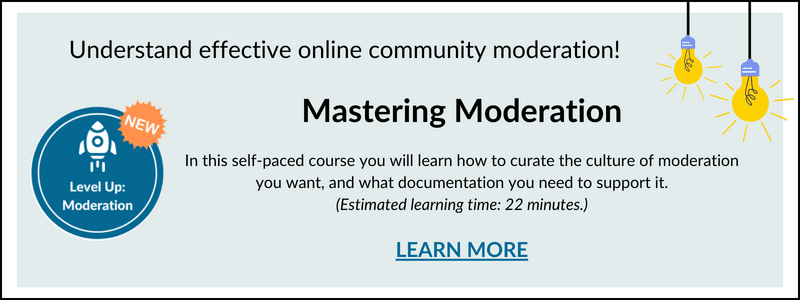![]()
We all know that a community manager’s to-do list can be daunting, if not paralyzing, at times. But what about a community moderator? Community moderation can be just as demanding.
For several years, I was the one and only official member of the community “team” for a large company. Among my many responsibilities was community moderation, so I got a firsthand view of what went into successful moderation and balancing the community management workload.
And while I could have written a few hundred pieces of advice, I’ve narrowed it down to ten you need to have a happy and healthy community (and moderator).
DO welcome new members to the community.
This is especially important when launching a new community. Acknowledge new members, reiterate the purpose of the community and encourage them to participate. (Check this great new member case study.)
DO show members how to participate.
Give new members a list of three things to do. These can include: Read the guidelines for participating; like a post you value or enjoy; search for a topic of interest; respond to a post you can contribute to.
DO establish clear guidelines for participation.
Your guidelines should focus on encouraging the behavior you’d like members to exhibit in addition to discouraging the conduct that is prohibited. Be firm and consistent in applying the guidelines to all members.
Do be sure you understand the question or issue.
Before you respond to a member’s post, read the post again. Especially in a customer support community it’s important to show that you understand the question and are genuinely interested in assisting. Too often I see a member respond “That’s not what I was asking. Did you even read my post?”
DON’T be a robot.
Respond in a sincere, personal voice. Some community moderation platforms provide the functionality of selecting a prepopulated response. Avoid using “canned” responses unless volume necessitates it.
DO be empathetic.
Always remember that the member you’re responding to may be justly upset and they’re looking to you for assistance. You represent your brand in the community and sometimes the brand will have done something wrong and the consumer is looking to you for help.
DO leverage analytics to evaluate your community’s content.
Example: Check frequently searched terms to see what your members are looking for. Make sure those topics have appropriate content posted and tagged accordingly.
DO acknowledge and nurture your Super Users.
It’s amazing how much support a small group of passionate, dedicated advocates can contribute. A quick note of appreciation, thanks or congratulations can go a long way.
DO use key word filters to screen all posts.
Key word filters can be used to screen obvious issues like profanity but they can also be used to alert you of potential issues. I’ve used them to search for potentially volatile political discussions, product issues and dissatisfied clients.

DON’T feed the trolls.
Every community has them. They’re only there to stir the pot. Deal with them calmly and within the guidelines. Depending on their behavior you can ignore them, warn them or send them away. (Here’s another great post about conflict resolution in communities.)

